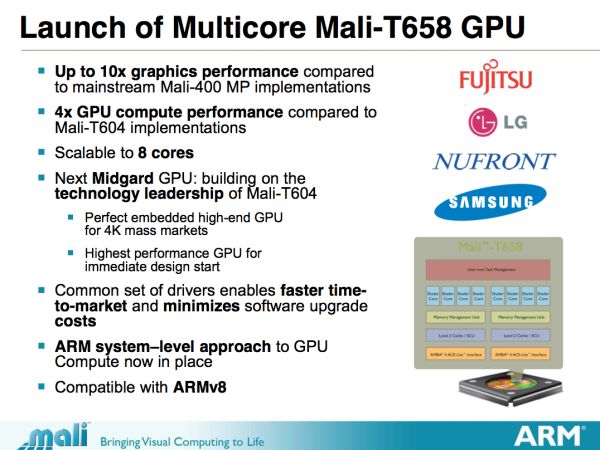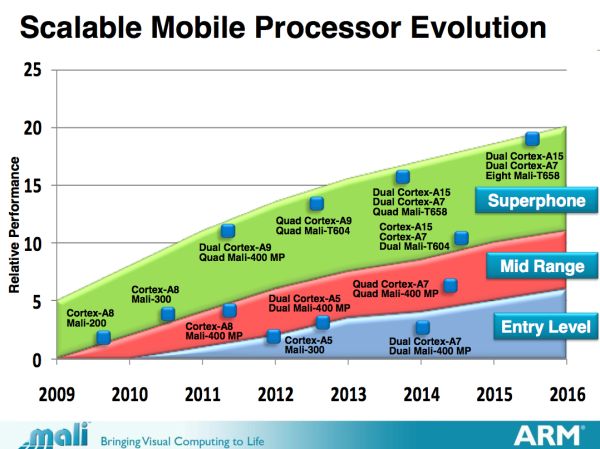ARM's Mali-T658 GPU in 2013, Up to 10x Faster than Mali-400
by Anand Lal Shimpi on November 9, 2011 8:30 PM ESTARM's licensed CPU cores dominate the mobile space. This year the core of choice for high-end smartphones and tablets is ARM's Cortex A9 and late next year it'll be the Cortex A15. ARM also offers GPU cores to its partners, although we've seen far more limited adoption compared to its CPU offerings. The limited adoption has nothing to do with a lack of performance though as we found in our review of Samsung's Galaxy S 2. ARM's Mali-400 MP4 is the fastest GPU we've tested on Android and second to only Imagination Technologies' PowerVR SGX 543MP2 across all of our mobile data.
The Mali-400, like NVIDIA's GeForce used in Tegra 2/3, doesn't feature a unified shader architecture - it has discrete pixel and vertex shader hardware. The Mali-400 is the last implementation of what ARM calls its Utgard architecture. Next year we'll see the Mali-400's successor: the Mali-T604.
The Mali-T604 was announced last year and it's the first implementation of ARM's new Midgard architecture. The T604 appears to be ARM's first unified shader architecture. Each T604 core is a combination of two arithmetic pipes and one texture pipe, although the width and capabilities of each are unknown. Like the Mali-400, the Mali-T604 will be available in 1 - 4 core configurations. The first T604 based SoCs will be available in the second half of 2012 on 28/32nm silicon. ARM is promising up to 68 GFLOPS of compute from T604 (presumably that's for a 4-core configuration at high clocks).
What comes after T604? ARM's Mali-T658 of course.
The T658 is a second generation Midgard implementation with twice the arithmetic pipes per core compared to the T604. ARM also enables up to 8-core configurations with T658. We'll see the first T658 implementations on 28/32nm sometime in 2013. It's unclear what other architectural changes have been made compared to the T604, but at bare minimum we can hope for a doubling of execution resources. ARM is promising up to a 10x increase in performance compared to "mainstream" Mali-400 implementations (perhaps single-core Mali-400).
Samsung is listed as a launch partner for Mali-T658, which isn't surprising given the company's use of Mali-400 in its Exynos 4210 (the SoC inside many of the Galaxy S 2s).
It's good to see ARM continue the evolution of its Mali graphics cores. Unlike in the PC market, there's almost no coupling between CPU and GPU IP providers in the mobile SoC space. ARM hopes to change that by offering very compelling GPUs in addition to its widely used CPUs cores. Since everything is already on a single chip however, it's unclear whether the mobile market will follow the same path - at least in the near term. The Mali-T604 and T658 will have their work cut out for them. There are new GPUs from Imagination, NVIDIA and Qualcomm that will be out over the next two years as well.

















21 Comments
View All Comments
arnavvdesai - Wednesday, November 9, 2011 - link
The reason I ask is because of the rumor currently regarding an ARM based architecture for the next Xbox.Given that almost certainly a large segment of the population now have 1080p TVs can these chipsets give a higher performance (or rather scale to such levels) than current generation high to mid range PC graphic cards?
Frankly, I have my doubts because relatively speaking they seem so weak.
PWRuser - Wednesday, November 9, 2011 - link
I doubt it. While these mobile parts also enjoy the benefit of progress (such as DX11 compatibility) there is not enough raw horsepower to "endanger" the stationary counterparts.If I had to guess, I would say these high end SoC's are comparable to 6-7 years old run of the mill desktop counter parts, edging them out here and there due to adopting innovations that came about since then.
MGSsancho - Wednesday, November 9, 2011 - link
Xbox360 is still more powerfull. At simular resolutions (480p) than the mali should be comparableB3an - Thursday, November 10, 2011 - link
The mail 400 isn't comparable to a 360 at ANY res. I know this, apart from obvious benchmarks, because i have a mali 400 GPU in my SGSII and use HDMI out to play games on my HD TV with it.But the Playstation Vita uses a quadcore ARM SoC. It has a 543MP4 GPU which is roughly equal to a PS3 in raw graphics power.
Theres no way the next gen consoles will use ARM though. The latest GPU's from Nvidia and AMD are so many more times more powerful, theres no comparison. Totally different market too, MS and Sony have no reason at all to use ARM, why would they? Consoles are devices that use mains power, they're not mobile, they can afford to have high end power eating GPU's and use 100+ watts.
Guspaz - Thursday, November 10, 2011 - link
The Mali 400 might not be, but the PowerVR SGX543MP4 isn't that far off, and the next generation of GPUs (like the Mali-T658 or a multi-core series 6 SGX) are definitely going to be decently faster than a 360. I mean, that was inevitable, the 360 came out 6 years ago, and if we compare it to mobile GPUs from a year or two in the future, it should be obvious. Even die shrinks alone get us 10.3x higher density than the 360 (90nm -> 28nm), and that's before architectural improvements.B3an - Friday, November 11, 2011 - link
The point i'm making is that theres no way the next gen consoles from MS or Sony will use any of these future ARM GPU's anyway, even if they are faster. They are designed for mobile low power devices. Thats a different market. Consoles run on mains power, and because of this can use GPU's from AMD and Nvidia that can use 100+ watts will be vastly faster than any ARM SoC for this reason alone.And a new console has to be many many times more powerful than the previous generation to really make a difference to most people, and it also has to last many years. If ARM was used, while the GPU might be faster, it wont be massively faster. AMD and Nvidia will certainly have vastly more powerful alternatives that would be used instead.
tipoo - Wednesday, December 7, 2011 - link
The Wii U uses an IBM Power 7 based processor and an AMD chip from the HD4000 series. If Microsoft and Sony used ARM SoC's they would have a hard time beating even that. No, no matter how powerful ARM chips and graphics will be by then, traditional architectures will be that much faster.Calin - Thursday, November 10, 2011 - link
You're comparing current generation, 40nm graphic chips (and graphic memory) running in 50-150W with mobile parts (and mobile memory) against 40nm or 28 nm, constrained at maybe 1-2W for mobile phones and possibly 5+W on tablets?I'd say they will be comparable to current generation integrated graphics (Llano, Sandy Bridge), not with any mid-range PC graphic cards
Guspaz - Thursday, November 10, 2011 - link
They're definitely optimized for power efficiency, but they do scale up more than anybody has used them for yet.The SGX 5XT line scales up to 16 cores, but the biggest we've seen in a smartphone is two cores (iPhone 4S with SGX543MP2), and the highest anybody seems to have planned is four (Playstation Vita with SGX543MP4). And something to keep in mind is that the SGX543MP taped out in January 2009, about three years ago.
If you consider that console hardware is pretty aggressive in terms of getting stuff ahead of the curve, and on new processes, a 16 or 32-core series 6 PowerVR chip on a 28nm process would start looking a lot like a desktop part (or at least a high-end notebook part), both in terms of performance and power consumption.
The thing is nobody has shown any interest in scaling PowerVR chips that high. I suspect that it's because, while they might be able to produce something in the same ballpark as whatever AMD/nVidia is going to put out, the focus on power efficiency over performance would be the wrong optimization strategy for home consoles (except Nintendo, it seems), and so it wouldn't be competitive.
MGSsancho - Thursday, November 10, 2011 - link
unless a new console will use a 16 core version. a console does not need to worry about total power use as much as a cell phone. 1w vs 10w or even 100w? these are all things consoles have the ability to handle (of course there have been problems getting them cool.) Although there would be an advantage to just using more cores in a console, would make it raiser to port games from hand held to consoles if we want to look at Microsofts triple screen idea